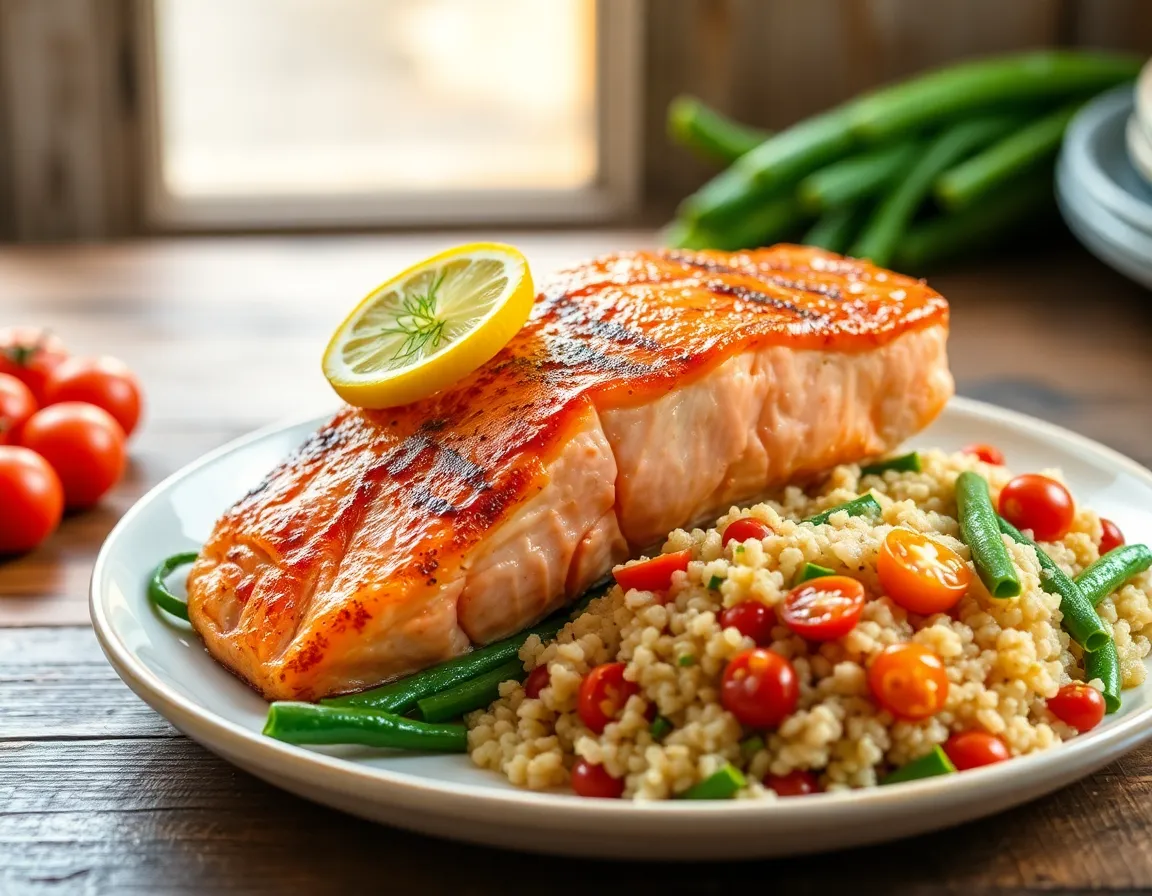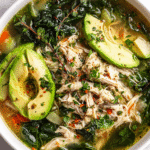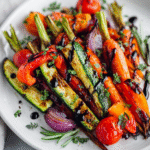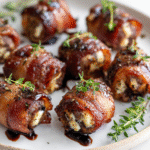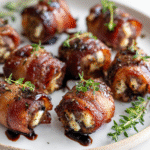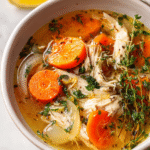Dive into a world of flavor with our Salmon Dinner Recipe, where the sizzle of the pan meets the fragrant dance of herbs and citrus. Whether you’re a kitchen novice or a seasoned chef, this dish transforms everyday ingredients into a symphony of savory delight, offering a stunning balance of tender salmon, zesty lemon, and fresh dill.
Imagine biting into perfectly cooked salmon, its buttery texture enhanced by a hint of garlic and a sprinkle of pepper. This recipe is your ticket to a restaurant-quality meal at home, promising an unforgettable dining experience that is as simple to prepare as it is delicious. Get ready to impress yourself and your tablemates with a dish that celebrates the joy of cooking and eating.
About This salmon dinner Recipe
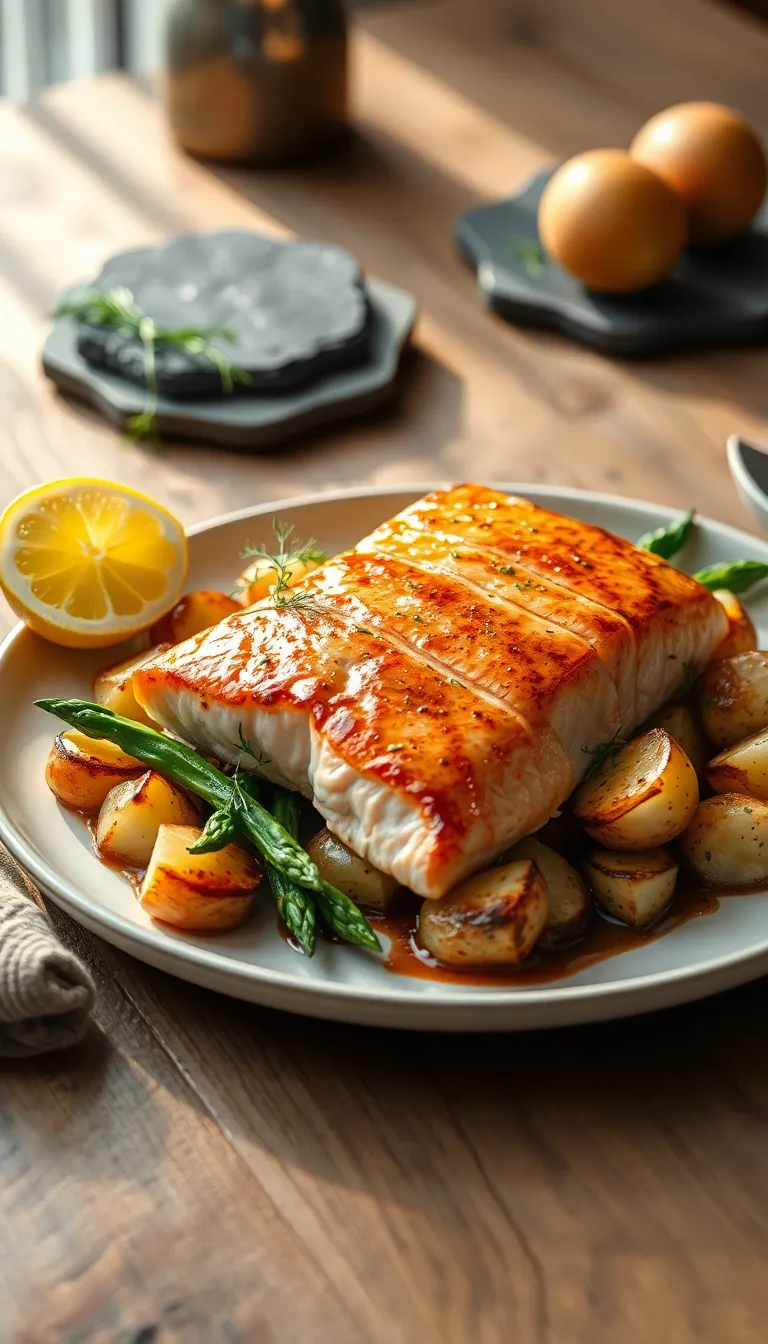
- Quick and Easy: This salmon dinner comes together in just 30 minutes, making it perfect for busy weeknights.
- Rich in Flavor: The combination of herbs and a hint of lemon enhances the natural taste of salmon, creating a deliciously balanced dish.
- Nutritious and Healthy: Packed with omega-3 fatty acids, this recipe is a heart-healthy choice that doesn’t compromise on taste.
- Versatile and Customizable: Pair it with your favorite sides, from roasted vegetables to a fresh salad, for a complete meal that suits any palate.
- Restaurant-Quality at Home: Impress your family and guests with a dish that looks and tastes like it came from a gourmet kitchen.
Why You’ll Love This Recipe
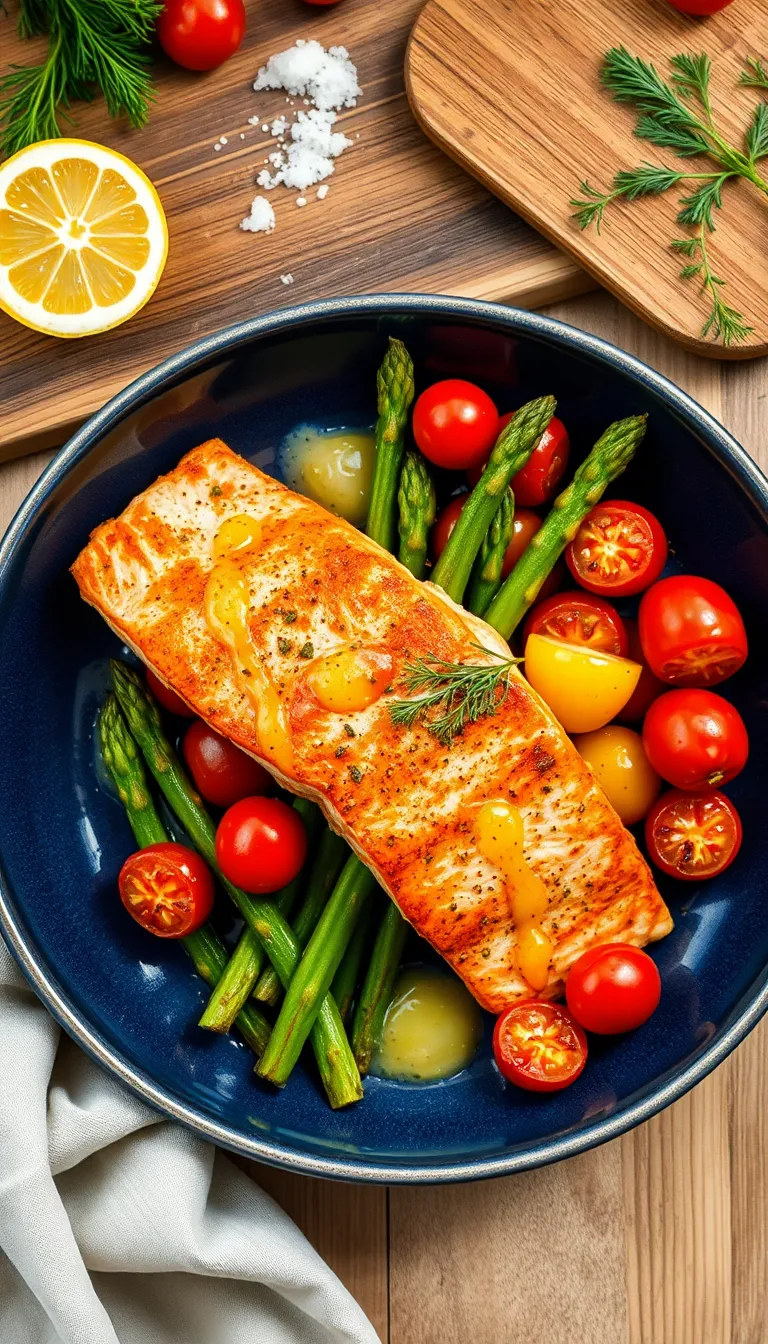
- Quick and Easy: This salmon dinner recipe can be prepared in under 30 minutes, making it perfect for busy weeknights.
- Rich Flavor Profile: The combination of herbs and lemon gives the salmon a burst of fresh, tangy flavor that is irresistible.
- Health Benefits: Packed with omega-3 fatty acids and high-quality protein, this dish is as nutritious as it is delicious.
- Minimal Ingredients: With just a few pantry staples, you can create a restaurant-quality meal at home.
- Versatile Accompaniments: Pairs effortlessly with a variety of sides, from roasted vegetables to a simple salad.
- Perfect for Any Occasion: Whether for a family dinner or a special gathering, this recipe is sure to impress.
Ingredients
- 4 salmon fillets (about 6 oz each)
- 1 tablespoon olive oil
- 1 teaspoon salt
- 1/2 teaspoon black pepper
- 1 lemon, sliced
- 2 tablespoons fresh dill, chopped (can substitute with parsley)
- 1/4 cup white wine (optional)
- 2 tablespoons unsalted butter
- 3 cloves garlic, minced
- 1/2 teaspoon red pepper flakes (optional, for heat)
- 1 pound asparagus, trimmed
- 1 tablespoon balsamic vinegar
- 1/4 cup cherry tomatoes, halved
- 1/2 teaspoon Italian seasoning (a blend of dried herbs like oregano, basil, rosemary)
- 2 tablespoons grated Parmesan cheese (optional, for garnish)
Ingredients
Kitchen Tools You’ll Need
- Chef’s Knife: Essential for slicing the salmon and chopping any vegetables you might include as a side. A sharp knife will make preparation easier and safer.
- Cutting Board: Provides a stable surface for slicing salmon and preparing other ingredients. Ensure it’s large enough to handle the size of the salmon fillets.
- Non-Stick Skillet: Ideal for searing the salmon. A non-stick surface helps prevent the fish from sticking, making it easier to flip and ensuring an even cook.
- Fish Spatula: Designed for flipping fish, its thin edge makes it easier to turn the salmon without breaking it. A regular spatula can be used if you don’t have a fish spatula.
- Measuring Spoons: Necessary for accurately measuring spices and other seasonings to ensure the right flavor balance.
- Mixing Bowl: Useful for combining any marinade or sauce ingredients before applying them to the salmon.
- Baking Sheet: If you plan to finish cooking the salmon in the oven, a baking sheet will be required. Line it with parchment paper for easy cleanup.
- Oven Mitts: Essential for safely handling hot pans or baking sheets when transferring cooked salmon from the oven.
Preparation Steps
- Preheat the oven to 400°F (200°C) and line a baking sheet with parchment paper to prevent sticking.
- Season the salmon fillets with salt and pepper on both sides for flavor enhancement. Ensure even seasoning for consistent taste.
- Place the salmon fillets skin-side down on the prepared baking sheet, ensuring they are spaced apart to allow even cooking.
- Drizzle olive oil over the salmon and add lemon slices on top to infuse a fresh, citrusy flavor. Use freshly squeezed lemon juice if preferred.
- Bake the salmon in the preheated oven for 12-15 minutes or until the fish flakes easily with a fork and appears opaque throughout.
- While the salmon is baking, prepare a simple side salad by combining mixed greens, cherry tomatoes, and cucumber slices. Add your favorite vinaigrette for a refreshing accompaniment.
- Remove the salmon from the oven and let it rest for 2-3 minutes before serving to allow juices to redistribute.
Serving Suggestions
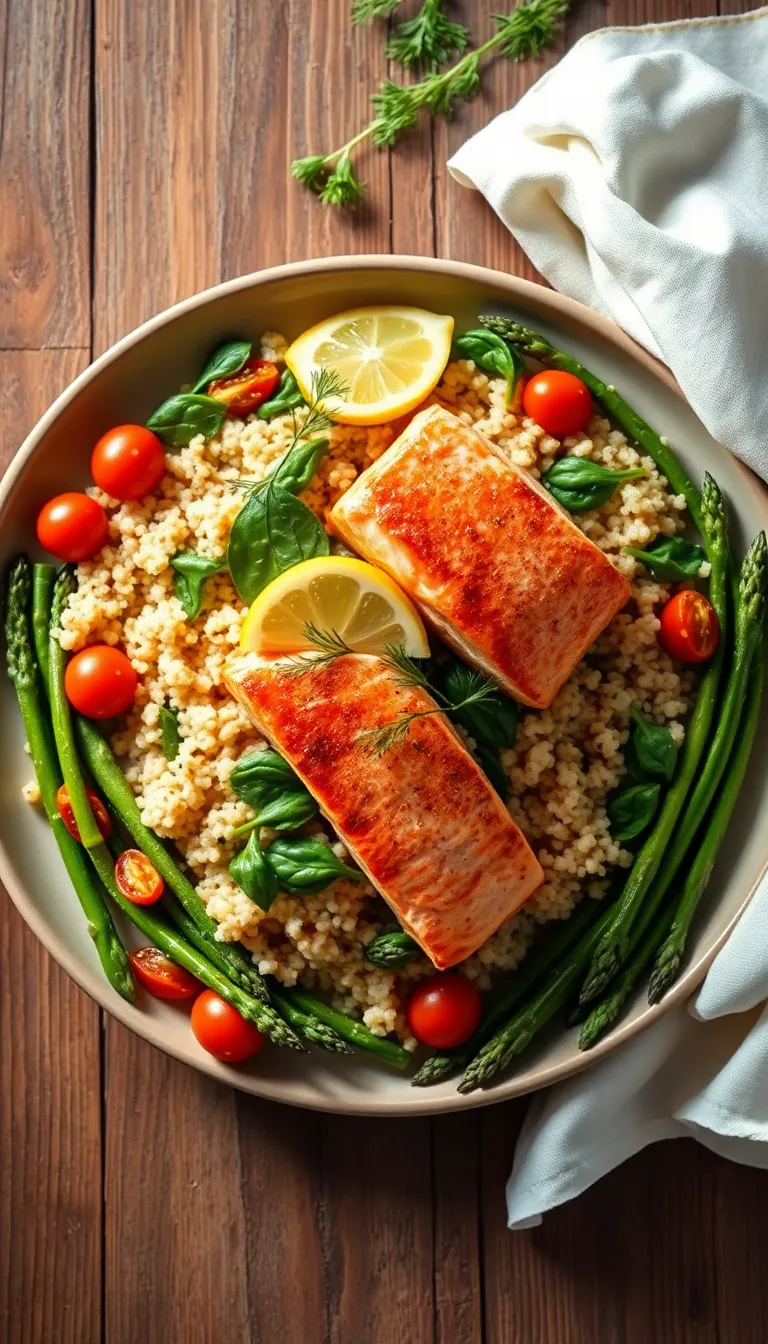
- Lemon Herb Rice: Serve the salmon over a bed of lemon herb rice. The citrusy flavor of the lemon complements the richness of the salmon, while the herbs add an aromatic touch.
- Roasted Asparagus: Pair the salmon with roasted asparagus. The earthy flavor of the asparagus balances the dish, and its vibrant green color adds a beautiful contrast to the plate.
- Mixed Green Salad: Accompany the salmon with a fresh mixed green salad topped with a light vinaigrette. This adds a refreshing element and a crisp texture that contrasts nicely with the tender salmon.
- Chardonnay or Pinot Noir: Serve with a chilled glass of Chardonnay or a light Pinot Noir. Both wines complement the salmon’s flavors, enhancing the dining experience.
- Garnish with Fresh Dill: Sprinkle fresh dill over the salmon before serving. Dill’s subtle flavor enhances the salmon, and its bright green color adds an elegant touch.
- Herb Butter: Add a pat of herb-infused butter on top of the salmon just before serving. The butter melts over the hot fish, adding richness and complexity to the dish.
Pro Tips for Perfect Results
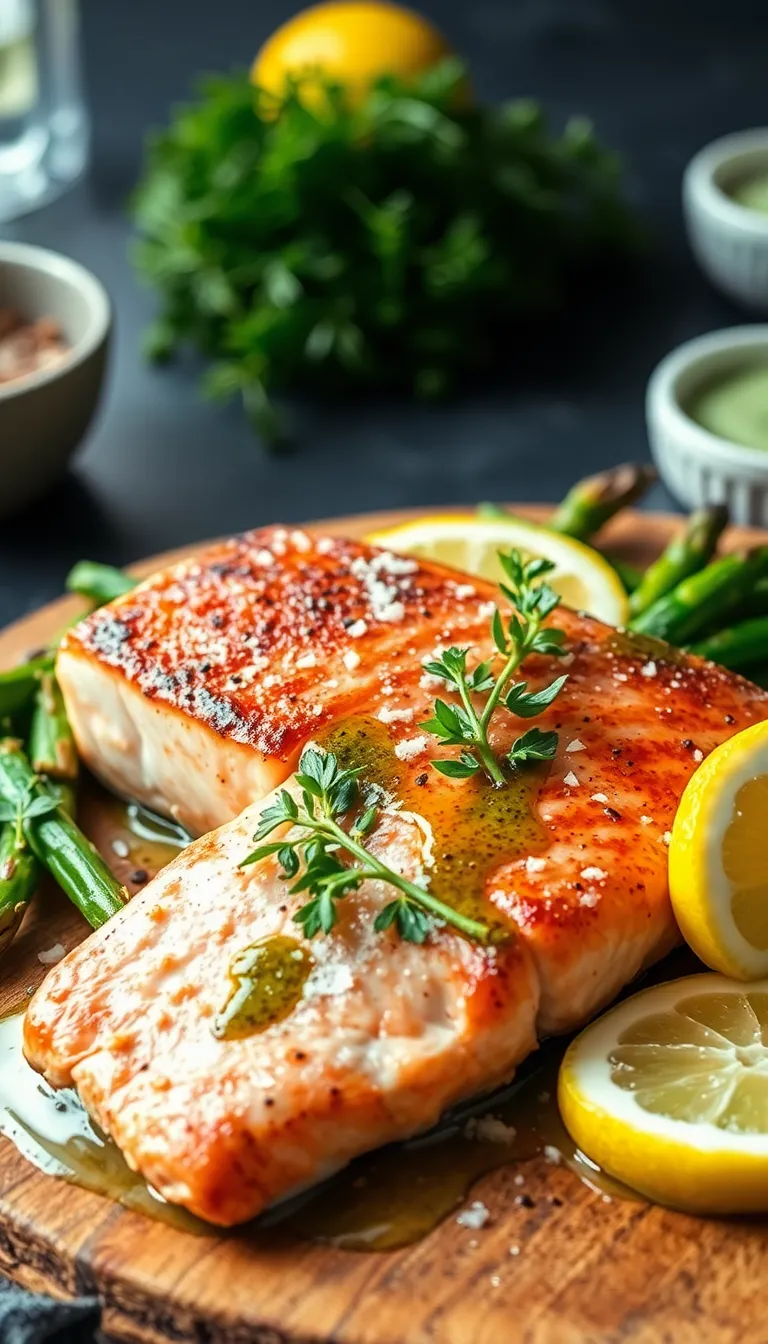
- Brine the Salmon: Soak the salmon in a simple brine solution (1/4 cup salt dissolved in 1 quart of water) for 15 minutes before cooking. This helps the fish retain moisture and enhances its natural flavor.
- Use a Citrus Zest Rub: Before cooking, rub the salmon with a mixture of lemon or orange zest and a pinch of salt. This adds a fresh, vibrant flavor that complements the richness of the fish.
- Preheat the Pan: Ensure your pan is thoroughly preheated before adding the salmon. This will help achieve a perfectly crispy skin without overcooking the flesh.
- Monitor Internal Temperature: Use a digital thermometer to check the internal temperature of the salmon. Aim for 125°F (52°C) for medium-rare. This ensures the fish is cooked perfectly without becoming dry.
- Make-Ahead Marinade: Prepare a marinade of olive oil, garlic, and herbs up to a day in advance. Marinate the salmon for at least 30 minutes to infuse the flavors, or refrigerate overnight for an even more intense taste.
- Chef’s Secret – Finish with a Compound Butter: Top the salmon with a pat of compound butter (butter mixed with herbs, lemon juice, or garlic) right before serving. It melts over the fish, creating a luscious sauce and adding depth to the flavor profile.
Common Mistakes to Avoid
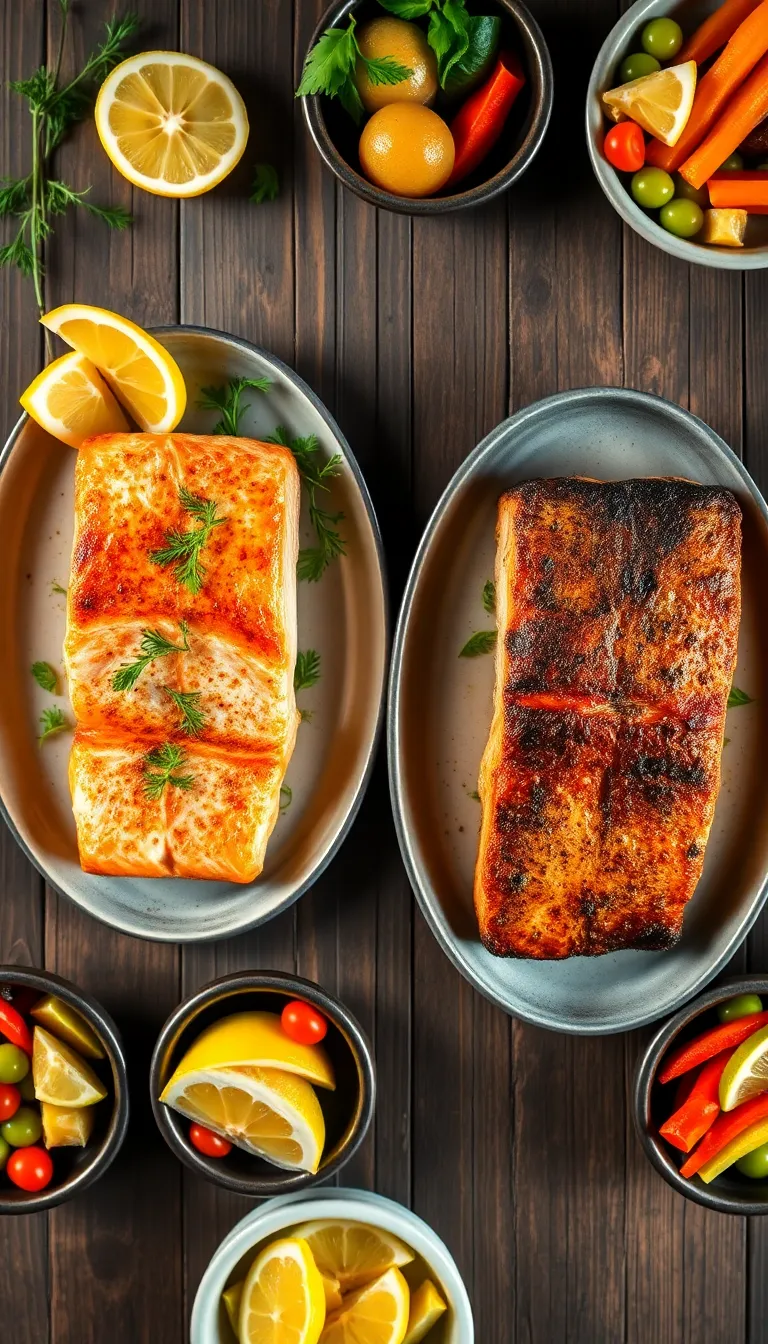
Common Mistakes to Avoid
- Overcooking the Salmon: This often happens because salmon can continue cooking even after being removed from heat. To avoid this, use a meat thermometer to check for doneness; salmon is perfectly cooked at 145°F (63°C). Remove it from heat just before it reaches this temperature to prevent overcooking.
- Not Seasoning Enough: Salmon has a rich, fatty flavor that benefits from a good seasoning. A common mistake is under-seasoning, which can result in a bland dish. Ensure you season both sides of the salmon generously with salt and pepper before cooking. Consider adding herbs or a marinade for extra flavor.
- Using the Wrong Cooking Method: Each method of cooking salmon—grilling, baking, or pan-searing—offers different results. Choosing the wrong method for your desired texture can lead to disappointment. For a crispy exterior, opt for pan-searing; for a moist and tender finish, baking is ideal.
- Not Using Fresh Salmon: Freshness is key to achieving the best flavor. Often, people use frozen salmon without properly thawing it, which can affect texture and taste. If using frozen salmon, ensure it is completely thawed in the refrigerator before cooking for the best results.
- Skipping the Resting Period: Just like other proteins, salmon benefits from a short resting period after cooking. Skipping this step can lead to uneven distribution of juices. Allow the salmon to rest for a few minutes after cooking to ensure it’s juicy and flavorful throughout.
Storage and Reheating Tips
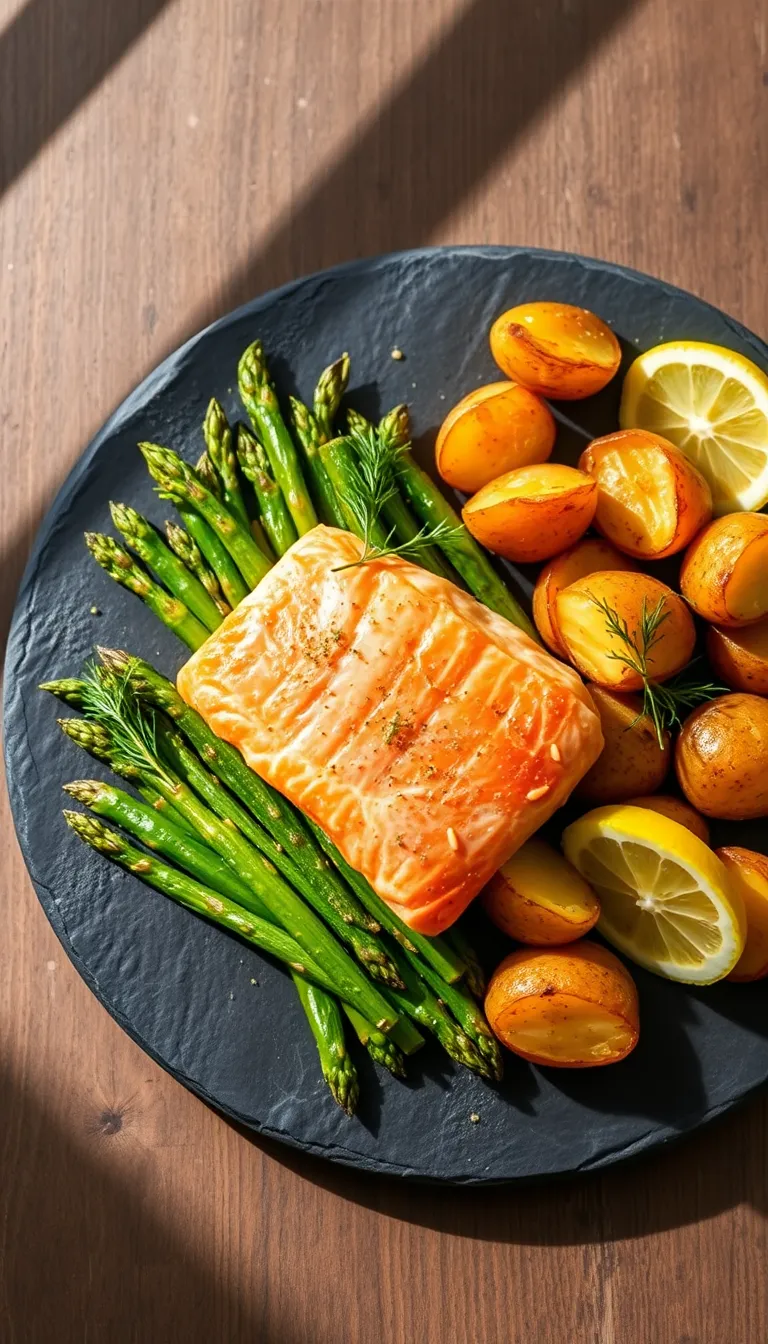
- Allow the salmon to cool to room temperature before storing to prevent condensation and sogginess.
- Store leftover salmon in an airtight container to maintain freshness and prevent odors from affecting other foods.
- Refrigerate the salmon within two hours of cooking to reduce the risk of bacterial growth.
- Keep the salmon in the refrigerator for up to 3 days. Consume it within this timeframe for optimal taste and safety.
- For longer storage, wrap the salmon tightly in plastic wrap or aluminum foil and place it in a freezer-safe bag or container. Label with the date and freeze for up to 2 months.
- To thaw frozen salmon, transfer it to the refrigerator and allow it to defrost overnight for even thawing.
- Reheat the salmon gently in the oven at 275°F (135°C) for about 10-15 minutes, or until heated through. Cover with foil to prevent drying out.
- Alternatively, reheat in a skillet over medium-low heat, adding a splash of water or broth for moisture. Cover the skillet with a lid.
- Avoid using the microwave for reheating salmon, as it can result in uneven heating and a rubbery texture.
- Always reheat leftovers to an internal temperature of 165°F (74°C) for safe consumption.
Final Thoughts: Proper storage and careful reheating of your salmon dinner can significantly enhance your leftover experience. By following these tips, you ensure the flavors and textures of your dish remain as delightful as the first day. Enjoy your meal safely and deliciously!
Frequently Asked Questions
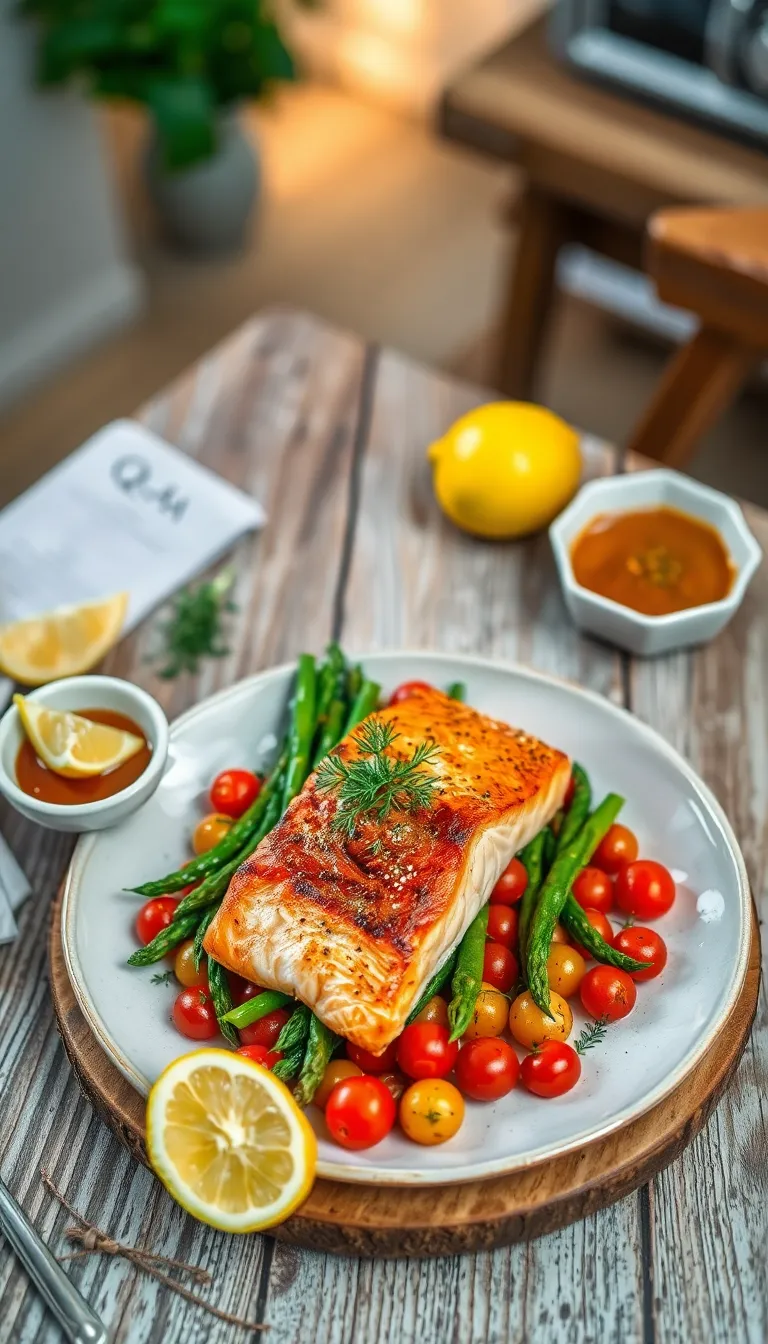
Frequently Asked Questions
Q: Can I use frozen salmon instead of fresh?
- Yes, you can use frozen salmon. Just make sure to thaw it completely in the refrigerator before cooking for the best texture and flavor.
Q: What can I substitute if I don’t have lemon juice?
- Try using lime juice or a small amount of white wine vinegar as a substitute for lemon juice to maintain acidity in the dish.
Q: How can I prevent my salmon from sticking to the pan?
- Ensure your pan is hot and add a bit of oil before placing the salmon skin-side down; this helps create a non-stick surface.
Q: What should I do if my salmon is overcooked?
- Try to moisten it by drizzling a little olive oil or a squeeze of lemon juice over the top to help restore some moisture.
Q: Can I add vegetables to this salmon dinner recipe?
- Absolutely! Add vegetables like asparagus or broccoli to the pan during the last few minutes of cooking for a complete meal.
Q: How do I know when the salmon is done?
- The salmon is done when it flakes easily with a fork and has reached an internal temperature of 145°F (63°C).
Final Thoughts: Cooking salmon can be an enjoyable and rewarding experience whether you’re new to the kitchen or a seasoned cook. By following the tips and suggestions in our FAQ, you can ensure a delicious outcome. Don’t hesitate to experiment with flavors and techniques to make the recipe your own!
Final Thoughts
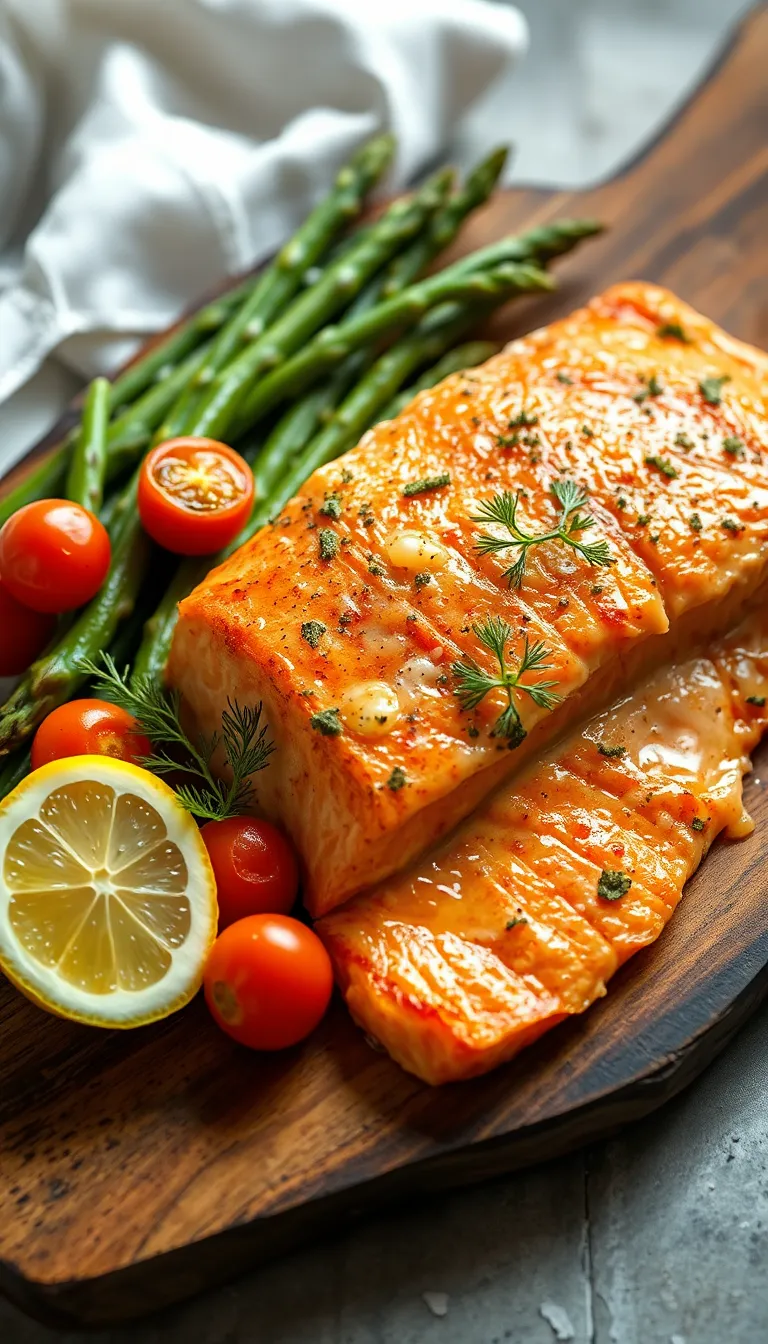
This salmon dinner recipe stands out for its perfect balance of flavor and simplicity. With just a few high-quality ingredients, you can create a dish that’s both elegant and delicious, making it ideal for both weeknight meals and special occasions. The combination of succulent salmon and fresh herbs is sure to become a favorite in your culinary repertoire.
Feel free to personalize this recipe by adding your own touches, whether it’s a different herb, a splash of lemon, or a side of your choice. Cooking is all about experimentation and creativity, so don’t be afraid to make this dish truly yours. Your kitchen is the place to express yourself and enjoy the process of creating something wonderful.
We warmly invite you to try this salmon dinner recipe and experience the joy of crafting a meal that’s both satisfying and impressive. Share it with your loved ones, and let it become a cherished part of your meal rotation. Happy cooking!
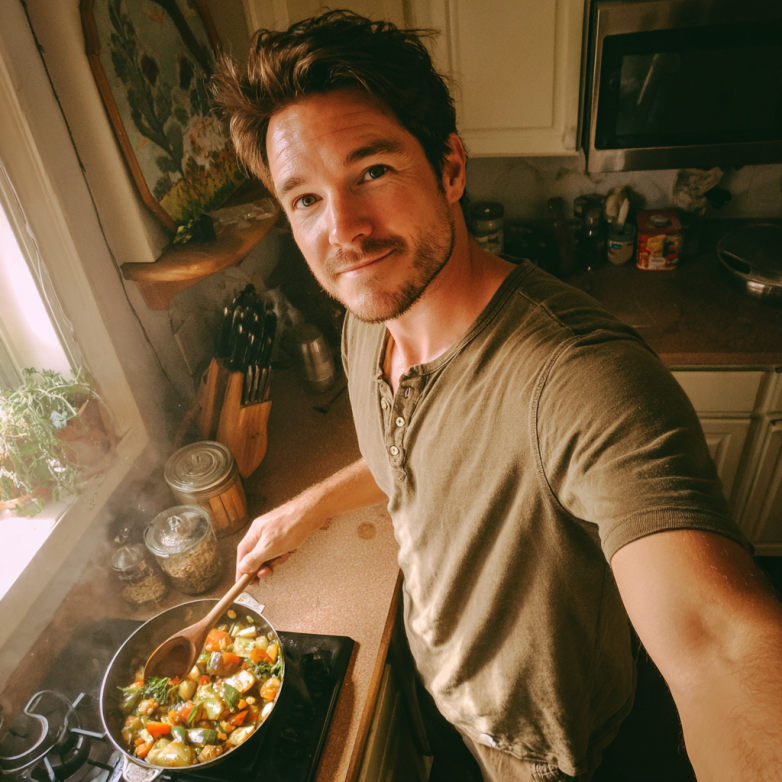
I’m Jonny, the cook, writer, and food lover behind this flavorful corner of the internet. Whether it’s a sizzling weeknight stir-fry, a no-bake dessert that saves the day, or a comforting Sunday classic — this blog is where I share recipes that are bold, doable, and made to impress without the stress.

